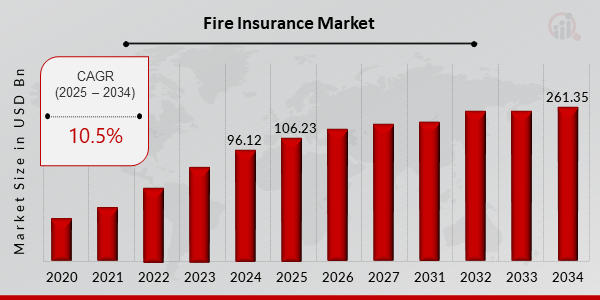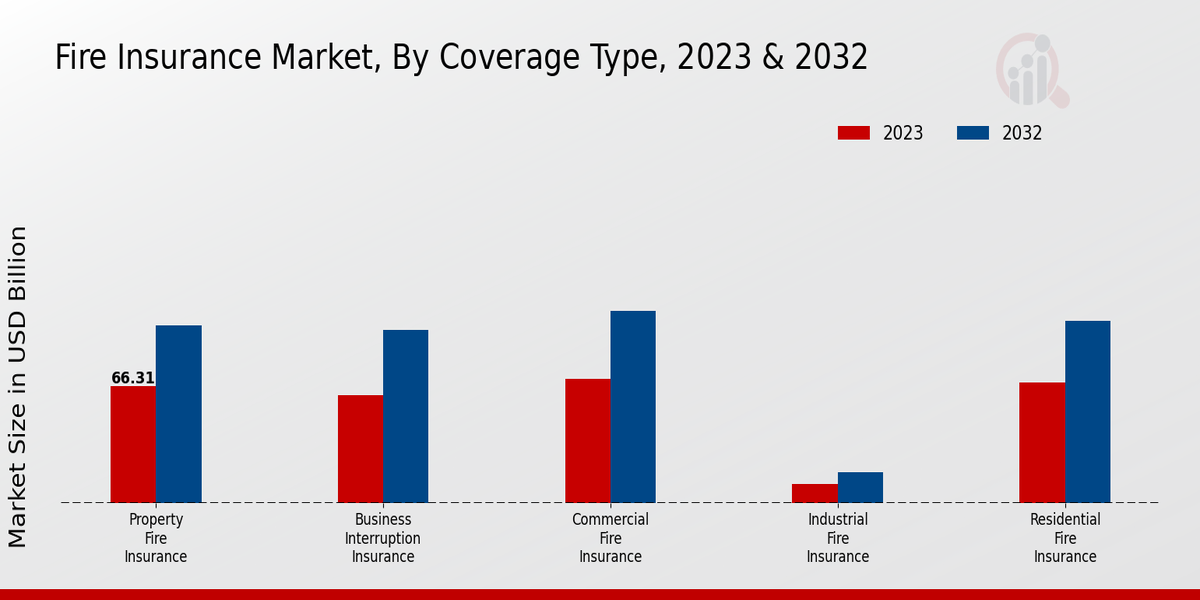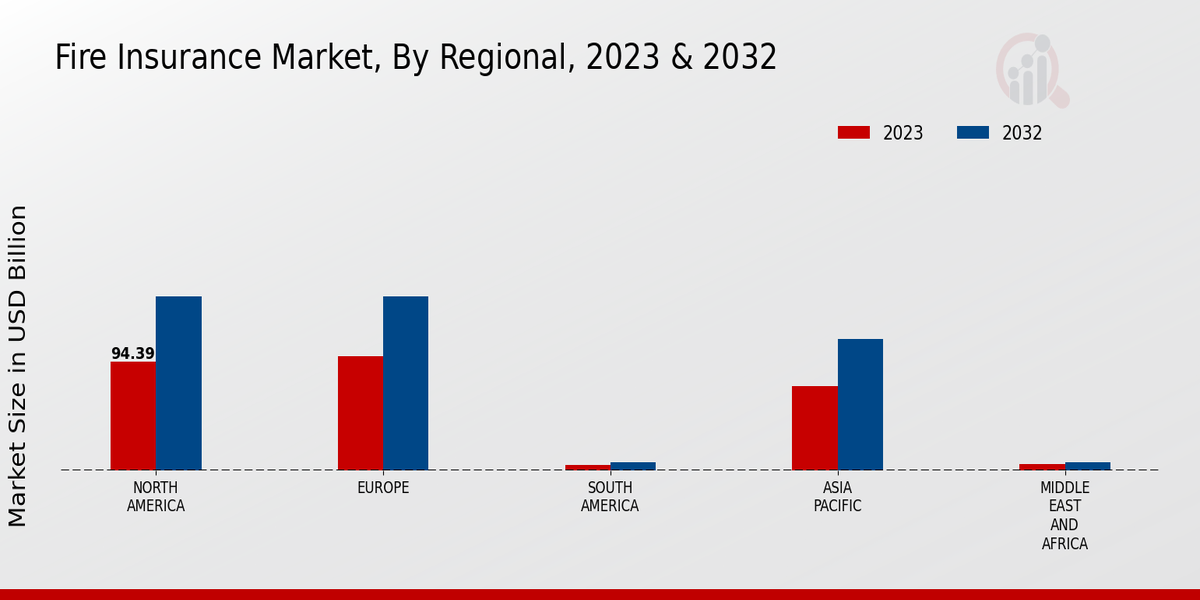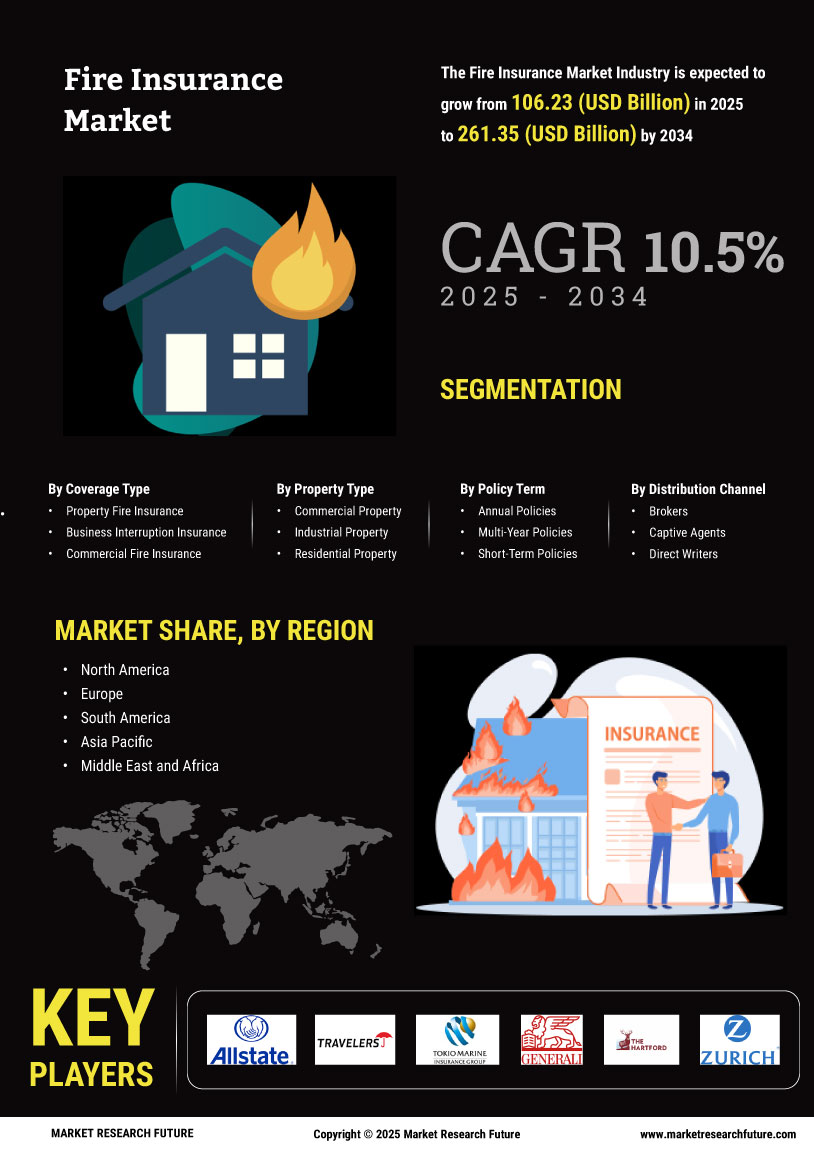Global Fire Insurance Market Overview
Fire Insurance Market Size was estimated at 96.12 (USD Billion) in 2024. The Fire Insurance Market Industry is expected to grow from 106.23 (USD Billion) in 2025 to 261.35 (USD Billion) by 2034. The Fire Insurance Market CAGR (growth rate) is expected to be around 10.5% during the forecast period (2025 - 2034).
Key Fire Insurance Market Trends Highlighted
The Fire Insurance market exhibits a dynamic landscape driven by several key trends. Firstly, the increasing frequency and severity of wildfires, driven by climate change, has heightened awareness of fire protection and the need for insurance coverage. Secondly, the rising adoption of fire safety technologies and regulations, such as fire alarms and sprinkler systems, is reducing the incidence of fire-related losses, thereby influencing policy pricing and coverage terms. Additionally, the growth of the construction industry, particularly in emerging markets, is creating new business opportunities for fire insurers.
Key market opportunities include the development of parametric insurance products, which provide immediate payouts based on predefined triggers, reducing the time and complexity of claims processes. Insurers are also exploring partnerships with technology providers to enhance risk assessment and loss prevention through data analytics and IoT devices. Furthermore, the increasing trend of remote work and hybrid work arrangements is driving demand for home fire insurance and business interruption coverage tailored to this evolving work model. Recent trends indicate a shift towards customized insurance solutions as businesses and individuals seek policies that meet their specific fire risk profiles.
Insurers are responding by offering flexible coverage options, including tailored deductibles and specialized endorsements. Additionally, the use of artificial intelligence (AI) is gaining traction in the fire insurance industry, with insurers leveraging AI-powered underwriting models to improve risk assessment and pricing accuracy. These trends are reshaping the Fire Insurance market and creating new avenues for innovation and growth.

Source Primary Research, Secondary Research, MRFR Database and Analyst Review
Fire Insurance Market Drivers
Increasing Awareness of Fire Risks and Regulations
One of the major drivers of the Fire Insurance Market Industry is the increasing awareness of fire risks and regulations. As businesses and individuals become more aware of the risks and potential dangers of fires, they are increasingly seeking out fire insurance policies to protect their assets and reduce their financial losses. Moreover, governments all over the world are demanding stricter fire safety regulations. For example, in the United States, the National Fire Protection Association has set up a fire safety code that is the most widely adopted model in developing fire codes for local governments.
The code holds businesses and property owners accountable for fires by requiring them to install fire alarms, sprinklers, and other fire safety equipment. This reduces the occurrence of fires and the severity of damage. Thus, the increasing awareness of the risk of fire and the demand for regulation are major factors that are expected to drive the growth of the Fire Insurance Market Industry.
Rising Value of Insured Assets
An additional driving factor of the Fire Insurance Market Industry is the rising value of insured assets. The economy is developing, and so are businesses and properties. Therefore, the demand for fire insurance is growing as there is more property to protect. In the United States, there are more than $ 50 trillion worth of insured assets, including businesses, homes, vehicles, and all kinds of property. This is expected to increase in the following years and, thus, will be a significant source of growth for the Fire Insurance Market Industry.
Technological Advancements
Technological advancements are also a factor that is primarily responsible for the increasing growth of the Fire Insurance Market Industry. The most relevant advancements are in the technologies that have the potential to prevent fires and reduce the degree of damage. For instance, in the modern world, there are smart home aids that can oversee the level of smoke, fire, and other risks in the house and alarm the homeowners. Besides, smart home technologies are applicable for stopping the flow of gas and electricity in the case of fire or another source of risk to prevent the fire from becoming an inferno.Overall, technology will promote the increasing growth of the fire insurance market.
Fire Insurance Market Segment Insights
Fire Insurance Market Coverage Type Insights
The Fire Insurance Market The Fire Insurance Market is segmented by Coverage Type into Property Fire Insurance, Business Interruption Insurance, Commercial Fire Insurance, Industrial Fire Insurance, and Residential Fire Insurance. Property Fire Insurance is the most common type of fire insurance, and it covers damage to buildings and personal belongings. Business Interruption Insurance covers lost income and expenses incurred by businesses.
Commercial Fire Insurance covers businesses and their property from fire damage. Industrial Fire Insurance covers industrial facilities and their contents from fire damage.Residential Fire Insurance covers homes and their contents from fire damage. The Property Fire Insurance segment is expected to account for the largest share of the Fire Insurance Market in 2023, with a market value of USD 120.34 billion. The Business Interruption Insurance segment is expected to be the fastest-growing segment, with a CAGR of 5.5% between 2024 and 2032.

Source Primary Research, Secondary Research, MRFR Database and Analyst Review
Fire Insurance Market Property Type Insights
The Fire Insurance Market is divided by Property Type into Commercial Property, Industrial Property, and Residential Property. Commercial Property is anticipated to hold the largest market share in 2023, generating about 45% of the Fire Insurance Market revenue. The factor influencing such growth of the segment is that there are numerous commercial buildings, and the property placed inside commercial establishments is of high value. Industrial Property is anticipated to be the most rapidly growing segment, reporting a CAGR of 6.5% in the forecast period.
The factor contributing to such a fast growth rate is that the probability of industrial property being affected by fire is high and more industrial businesses require fire insurance policies since the number of fire cases is increasing. Residential Property is also expected to generate a significant share of the Fire Insurance Market revenue because the percentage of homeowners is rising, and the quality of residential property is increasing.
Fire Insurance Market Policy Term Insights
The Policy Term segment of the Fire Insurance Market is segmented into Annual Policies, Multi-Year Policies, and Short-Term Policies. Annual Policies accounted for the largest share of the market in 2023 and are expected to continue to dominate the market over the forecast period. The growth of this segment can be attributed to the increasing demand for short-term insurance policies by businesses and individuals.
Multi-Year Policies are expected to witness a significant growth rate during the forecast period, owing to the increasing adoption of long-term insurance policies by businesses and individuals.Short-Term Policies are expected to account for a small share of the market due to the increasing preference for long-term insurance policies. The Fire Insurance Market revenue for the Policy Term segment is expected to reach USD 280.4 billion by 2024, growing at a CAGR of 5.2%.
Fire Insurance Market Deductible Insights
The deductible segment plays a significant role in shaping the dynamics of the Fire Insurance Market. Policies with high deductibles typically result in lower premiums, making them attractive to businesses and individuals seeking to reduce insurance costs. However, higher deductibles also mean that policyholders bear a greater financial responsibility in the event of a covered loss. In 2023, the market for high deductible fire insurance is expected to be valued at 125.43 (USD Billion), growing at a CAGR of 4.5%. This growth is attributed to increasing cost-consciousness among businesses and individuals, as well as a growing awareness of the benefits of high deductible insurance.
On the other hand, low deductible fire insurance offers more comprehensive coverage, with lower out-of-pocket expenses in the event of a claim. The market for low deductible fire insurance is expected to reach 151.26 (USD Billion) by 2032, expanding at a CAGR of 4.8%. The demand for low deductible insurance is likely to be driven by the preference for more comprehensive coverage, especially among residential property owners and high-value businesses.
Fire Insurance Market Distribution Channel Insights
The distribution channel segment plays a crucial role in the Fire Insurance Market, influencing the accessibility and reach of insurance products to policyholders. Brokers, captive agents, direct writers, and independent agents are the primary distribution channels in the market. Brokers serve as intermediaries between insurance companies and policyholders, offering expertise and access to multiple insurers. Captive agents represent a single insurance company, providing personalized service and in-depth knowledge of the insurer's products.
Direct writers sell insurance directly to consumers, eliminating intermediaries and offering potentially lower premiums. Independent agents, similar to brokers, represent multiple insurers but are not tied to any specific company, providing unbiased advice and a wide range of options to policyholders. The Fire Insurance Market revenue is expected to grow significantly in the coming years, and the distribution channel segment is poised to benefit from this growth. By leveraging their expertise, networks, and customer relationships, distribution channels play a vital role in ensuring the efficient and effective delivery of fire insurance products to businesses and individuals worldwide.
Fire Insurance Market Regional Insights
North America, Europe, APAC, South America, and MEA are the key regional segments of the Fire Insurance Market. North America held the largest market share in 2023 and is projected to maintain its dominance throughout the forecast period. The region's well-developed insurance industry, stringent fire safety regulations, and high awareness of fire insurance products are key factors driving the market growth. Europe is another significant region with a mature fire insurance market and a strong regulatory framework.
The APAC region is expected to witness the highest growth rate during the forecast period, owing to increasing urbanization, rising disposable income, and growing awareness of fire insurance.South America and MEA are emerging markets with significant growth potential. The increasing adoption of fire insurance products in these regions is expected to drive market growth in the coming years.

Source Primary Research, Secondary Research, MRFR Database and Analyst Review
Fire Insurance Market Key Players And Competitive Insights
Leading players operating in the fire insurance market are continuously innovating and developing new products and services to cater to the changing needs of customers. Moreover, leading players in the fire insurance market industry are also heavily investing in research and development to enhance their market position. Due to the increasing demand for fire insurance policies across the globe and increasing awareness about fire safety standards, the Fire Insurance Market industry is expected to witness significant growth in the forthcoming years.
The competitive landscape of the Fire Insurance Market is highly consolidated and contrasting in nature. The presence of several well-established players is competing with many other local and regional players in the Fire Insurance Market. Major giant players in the Fire Insurance Market include Allianz, AIG, AXA, Berkshire Hathaway, Chubb, Generali, Hannover Re, Liberty Mutual, Munich Re, Swiss Re, Tokio Marine, XL Catlin, and Zurich Insurance Group. These companies constitute a significant share of the Fire Insurance Market.
Allianz is one of the largest leading players operating in the Fire Insurance Market. Allianz is a German multinational financial services company with its headquarters in Munich, Germany. It is the world’s largest insurance company by revenue and one of the premier financial services companies across the globe. Allianz offers a broad range of insurance products and services, including fire insurance, property insurance, casualty insurance, life insurance, and health insurance, among others. The company has a wide geographical presence across the globe. It operates in over 70 countries. Its large geographic presence and product range make it a highly desirable player in the Fire Insurance Market.
AIG is one of the competitors in the fire insurance market. AIG is an American multinational insurance and financial services company with its headquarters in New York City. It is one of the largest insurance companies in the world by revenue and also one of the largest financial services companies globally. The company offers a broad range of insurance products and services, including fire insurance, property insurance, casualty insurance, life insurance and health insurance, among others. AIG has a significant geographical presence across the globe and operates in over 80 countries.
Key Companies in the Fire Insurance Market Include
- Allstate Insurance Company
- Travelers Companies, Inc.
- Tokio Marine Nichido Fire Insurance Co., Ltd.
- Generali Group
- The Hartford Financial Services Group, Inc.
- Zurich Insurance Group Ltd
- Nationwide Mutual Insurance Company
- State Farm Mutual Automobile Insurance Company
- Ping An Insurance (Group) Company of China, Ltd.
- Munich Reinsurance Company
- Allianz SE
- Farmers Insurance Group of Companies
- Chubb Ltd.
- AXA SA
- Liberty Mutual Insurance Group, Inc.
Fire Insurance Market Industry Developments
The fire insurance market is projected to reach USD 429.69 billion by 2032, exhibiting a CAGR of 5.01% from 2024 to 2032. Rising fire incidents, increasing urbanization, and growing industrialization drive market growth. Technological advancements, such as AI and IoT, enhance risk assessment and claims processing, further fueling market expansion. The Asia-Pacific region is anticipated to witness significant growth due to rapid industrialization and urbanization. Key industry participants include Allianz, AXA, Chubb, and Zurich Insurance Group. Recent market developments include the launch of parametric fire insurance products, collaborations between insurers and technology providers, and the implementation of stricter fire safety regulations worldwide.
Fire Insurance Market Segmentation Insights
-
Fire Insurance Market Coverage Type Outlook
- Property Fire Insurance
- Business Interruption Insurance
- Commercial Fire Insurance
- Industrial Fire Insurance
- Residential Fire Insurance
-
Fire Insurance Market Property Type Outlook
- Commercial Property
- Industrial Property
- Residential Property
-
Fire Insurance Market Policy Term Outlook
- Annual Policies
- Multi-Year Policies
- Short-Term Policies
-
Fire Insurance Market Deductible Outlook
- High Deductible Fire Insurance
- Low Deductible Fire Insurance
-
Fire Insurance Market Distribution Channel Outlook
- Brokers
- Captive Agents
- Direct Writers
- Independent Agents
-
Fire Insurance Market Regional Outlook
-
North America
-
Europe
-
South America
-
Asia Pacific
-
Middle East and Africa
| Report Attribute/Metric |
Details |
| Market Size 2024 |
96.12 (USD Billion) |
| Market Size 2025 |
106.23 (USD Billion) |
| Market Size 2034 |
261.35 (USD Billion) |
| Compound Annual Growth Rate (CAGR) |
10.5% (2025 - 2034) |
| Report Coverage |
Revenue Forecast, Competitive Landscape, Growth Factors, and Trends |
| Base Year |
2024 |
| Market Forecast Period |
2025 - 2034 |
| Historical Data |
2020 - 2023 |
| Market Forecast Units |
USD Billion |
| Key Companies Profiled |
Allstate Insurance Company, Travelers Companies, Inc., Tokio Marine Nichido Fire Insurance Co., Ltd., Generali Group, The Hartford Financial Services Group, Inc., Zurich Insurance Group Ltd, Nationwide Mutual Insurance Company, State Farm Mutual Automobile Insurance Company, Ping An Insurance (Group) Company of China, Ltd., Munich Reinsurance Company, Allianz SE, Farmers Insurance Group of Companies, Chubb Ltd., AXA SA, Liberty Mutual Insurance Group, Inc. |
| Segments Covered |
Coverage Type, Property Type, Policy Term, Deductible, Distribution Channel, Regional |
| Key Market Opportunities |
Expanding commercial real estate constructionIncreasing awareness of fire prevention measuresTechnological advancements in fire detection and suppression systemsRising incidence of wildfires and natural disastersGovernment regulations and compliance requirements |
| Key Market Dynamics |
Rising urbanization increasing property values Increasing frequency and severity of natural disasters Technological advancements, e.g., IoT data analytics Growing demand for customized insurance solutions Expanding market in emerging economies |
| Countries Covered |
North America, Europe, APAC, South America, MEA |
Frequently Asked Questions (FAQ) :
The Fire Insurance Market is expected to reach USD 96.12 billion in 2024 and is projected to grow at a CAGR of 10.5% to reach USD 261.35 billion by 2034.
North America is the largest region in the Fire Insurance Market, accounting for over 40% of the market share. Europe and Asia-Pacific are other key regions with significant market shares.
Fire Insurance is primarily used to protect businesses and individuals from financial losses caused by fire damage to property, buildings, and other assets.
Some of the key competitors in the Fire Insurance Market include Allianz, AIG, AXA, Berkshire Hathaway, Chubb, Generali, Hannover Re, Liberty Mutual, Munich Re, and Swiss Re.
The increasing frequency and severity of natural disasters, rising property values, and growing awareness of fire safety regulations are some of the key growth drivers of the Fire Insurance Market.
Climate change, increasing competition, and regulatory changes are some of the key challenges faced by the Fire Insurance Market.
Digitalization, the use of telematics, and the development of new insurance products are some of the key trends in the Fire Insurance Market.
The Fire Insurance Market is expected to continue growing in the coming years, driven by increasing demand for fire insurance coverage and the expansion of the insurance sector in emerging markets.
Expanding into new markets, developing innovative insurance products, and leveraging technology to improve customer service are some of the key opportunities for growth in the Fire Insurance Market.
Climate change, increasing competition, and regulatory changes are some of the key challenges that need to be addressed in the Fire Insurance Market.

















